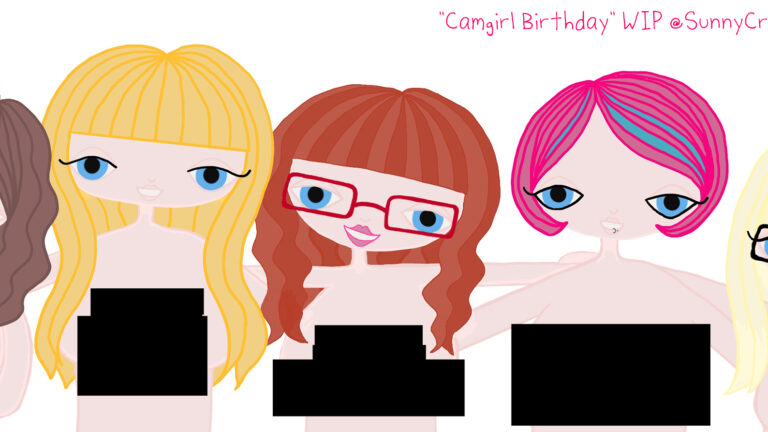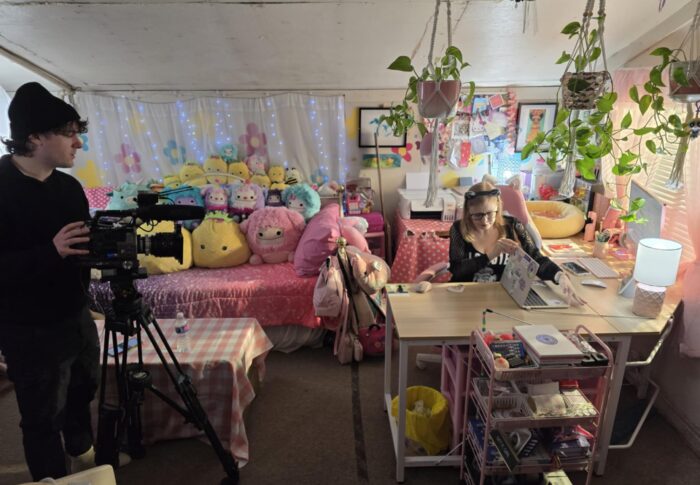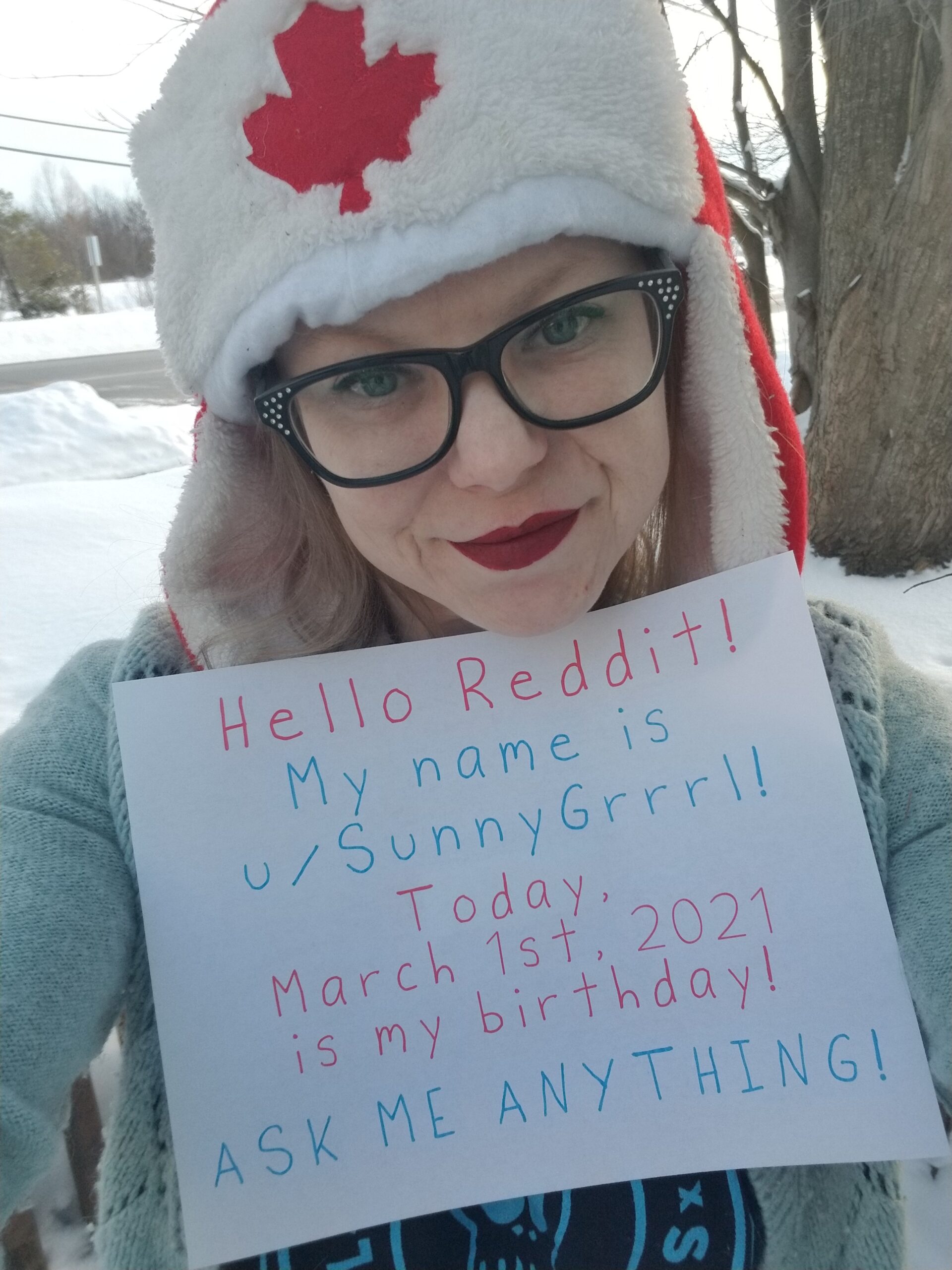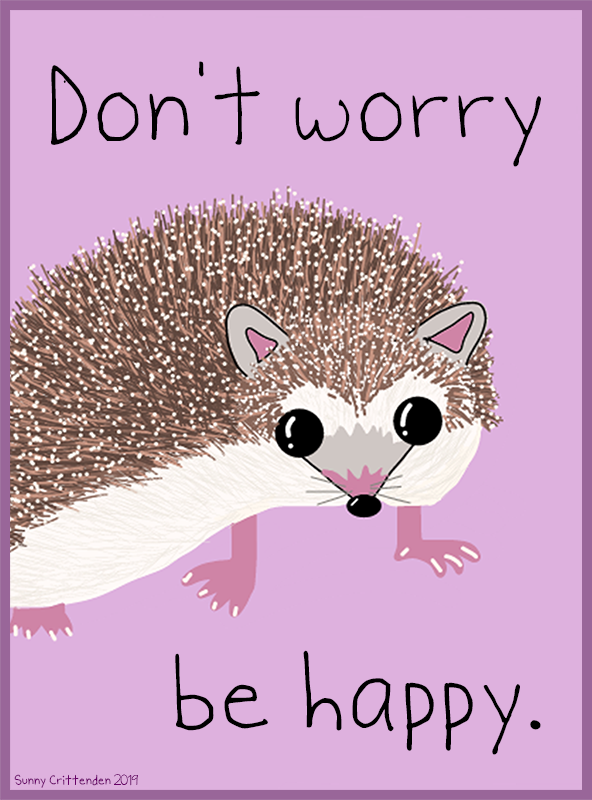
The Wild Wild World Of NFTs
The Wild Wild World Of NFTs
You’ve probably seen the SNL skit about NFTs that aired last night by now, or maybe you’ve seen the headlines that an artist named Beeple sold an NFT for $69 million at a Christie’s auction recently, or possibly you’re an art lover who’s heard about the “Burnt Banksy” and you feel like you’re losing your mind with all this madness! Or maybe you’ve just seen me posting all over Patreon, Twitter, and Facebook about NFTs, and have no idea what I’m so excited about and would like to know more. Whatever the case, I’m gonna try my best to write a basic guide about them here that’s shorter than the free, public Patreon post I made this week, that is 5k words and was more written for fellow artists on how and why to make NFTs. I’m going to try to not confuse anyone because with NFTs, it’s easy to get confused. There are a lot of formerly abstract ideas about art, collectibles, and value that are now concrete or possible that take an open-mind and a bit of good faith to really understand. The important thing to remember is that just because something is new and you don’t understand it, it doesn’t mean it’s not worth knowing and it should be automatically dismissed as not applicable to you or labelled “bad”. That is typically an older, dare I say, boomer way of thinking, and I dunno about you, but I’m not ready to start shaking my cane at the kids just yet. If ever. So, let’s begin!
What is an NFT?
An NFT stands for “non-fungible token”, which, when talking about art, is a fancy way to say a digital certificate of authenticity, that the artist creates and digitally “signs”, for a piece of attached digital art that is ownable, buyable, tradeable, and saleable, that gets traced and tracked from owner to owner, but ultimately always leads back to the work’s original artist. Or more to the point, leads back to the artist’s account info on whatever NFT marketplace platform they signed up for and created, or “minted”, the NFT on. As long as the artist (or representative) and marketplace maintain mutual web presence, the NFT is essentially eternal. Each NFT is 100% unique to one piece of art, like a digital serial number, and while I’m sure one day, maybe 200 years from now or something, they could be faked or possibly even be stolen, right now the system they run on (here’s that scary “blockchain” word, which we can mostly ignore from now on because knowing the details of it is not required to have fun making and collecting NFTs and being part of this new community) is more secure than the system that runs the internet we’re using right now. You can just call it Web 3.0 if that makes more sense to you. It’s the internet to come, and it has its own currencies, called cryptocurrencies. The main one for buying and selling NFTs is called “Ether”, just like Bitcoin, but it runs on its own scary blockchain, which is just a LOT of home computers run by someone like you or me, all working together to support a more complex, and thus secure, network or system rather than the big computer “servers” that power the internet we’re on right now. At least, this is my very basic understanding and if this all still sounds confusing, let me reiterate: you do not need to understand what a blockchain is unless you want a deeper understanding of the system that supports the creation and marketplace for NFTs. (For my cam friends out there, just pretend Ether is like tokens on MyFreeCams but the artist or creator gets a WAAAAAAAY better deal than MFC’s 50/50 payout.)
To see an example of an NFT, take a look at the NFT I created from one of my digital works, called “Weed Bath”. You have to accept the concept that digital art can be owned, making this piece of cryptoart transferable from one owner to the next for fun and profit. Only the owner of this NFT can claim that they bought the piece of art directly from and supported me, the artist, making them able to freely display it however they see fit or even just enjoying it privately, and basically getting bragging rights, just like buying an original painting from me because each NFT is unique. There is only one of these. Even if I made another NFT out of the same image or file, it would be unique because NFTs are non-fungible and cannot be exchanged on a 1:1 basis, just like an authorized, printed piece of art of an edition, and the art market would/should value both as such.
Built into each NFT is its transaction history from owner to owner, and I think even offers to buy it are included in this history, giving the NFT provenance just like wine or analog art as we think of it now, which adds value over time. So each NFT is unique and collectible, and due to their very nature, could be valuable to collectors over time for a lot of money just like a baseball card, or scarce comic book, or rare or limited piece of art or fashion.
What makes an NFT different from just a jpg or screenshot I download from the internet for free now?
Anyone can make or download an exact replica of an image or most digital files on the internet right now easily and for free and that doesn’t change with NFTs. The difference between an NFT and a copy of an NFT is the value. If you take a photo of the Mona Lisa, even the best photo ever taken of the Mona Lisa, or say you painted one so identical, it would be impossible for any living human to tell the difference between the two, if it’s not the one painted by Da Vinci that hangs in the Louvre, it will never has as much value because it’s not the real, authentic, 1/1 thing created and signed by the original artist.
If someone took a piece of my digital art and made an NFT from it and sold it for $5000, that would actually be good for me because – pending I found out, which is the difficult part, the same as copyright now – if I then turned around and made my own from the same image, mine would be worth more because it’s authentic. The other one is fake, a forgery, just like a painting, and the person who made it is an unethical asshole just like people who make and sell unauthorized branded merch and fake Chanel bags. (If I cared about them, I would buy fake Chanel bags tho, because some fakes are so good, they have value of their own. NFTs being digital and so easily created, not so much.)
Again, you have to do a bit of a brain exercise here and accept that an NFT is unique and ownable. Yes, you can “own” a jpeg by downloading the file and keeping it on your computer, but that jpeg is not an NFT. An NFT is a new digital product and when you buy an NFT, you own the NFT itself, the certificate of authenticity, not just the actual visual representation of it like you would from saving a jpeg from the internet. The NFT itself is the thing that is unique and has value.
What are the benefits of artists making and selling NFTs? And how do I do it?
The benefits of making and selling NFTs for an artist, are that finally, there IS a way to make a living from digital art itself. Previously, artists were forced to make digital artworks analog in order to sell them. If not, due to its easily copied and generally unprotected nature, all digital art basically had no real value. There are thousands, if not millions, of digital artists in the world making art because they’re good at and love doing it, but none of that art had value unless made into a tangible, a thus more valuable, form.
Not only can artists make and sell NFTs, they can set a commission percentage that will be collected for them automatically on all future sales of that NFT in perpetuity, much like how actors or their estates get paid royalties from being in movies even after they’re dead. This has never been an option for us before either. I’ve never heard of a gallery offering this kind of contract on a piece if art before. It may happen and I’m just ignorant of them, but I’ve never heard of it. Once a painting is sold once, the artist is cut out of all future profits. When you hear about a famous artist’s painting selling for millions of dollars at Christie’s or Sotheby’s art auctions, it’s almost never the artist selling or profiting from that sale directly. It’s someone who bought it after it already changed hands 10s or 100s of times for a lot of money to begin with or they bought it early in the artist’s career from the artist for a starving artist’s price and is trying to selling it for a higher profit. The artist only gets money from the original sale. Once.
NFTs give artists a seat at a very lucrative table only afforded by a few mediums, like movies and music, without having to deal with typical industry gatekeepers like agents and gallerists and the people who run art fairs. With NFTs, the artist themselves has to create them, like any other kind of art, for them to have value, so they have to figure it out and do it. A gallery or agent can’t do it for them any more than they could make the artist’s art for them.
Galleries can still come to play though, and I think they will eventually. A gallery can create an account on an NFT marketplace and collect NFTs at a lower price (or even be transferred to for free) and sell them for higher using their name, reputation, and client list. An artist could still benefit from a gallery “representing” them, by transferring ownership of their NFTs to the gallery, the gallery handles sales and sells them at a higher price, and the artist still receives commissions on all sales in perpetuity.
Yes, you will be paid and all transactions will be in cryptocurrency, but I am assured Ether is easy to “cash out” or convert into USD and deposit into your bank account. Beeple did it with $69 million, pissing off a lot of cryptogeeks by taking funds out of the system and lowering the price of Ether, so it can be done. I haven’t sold anything yet and I plan to leave 50% of my Ether as Ether if I do, so I don’t know yet from personal experience if that’s true.
For how to actually make an NFT, you’ll have to read my super long, excited post about it on Patreon that explains the process.
What is the benefit of buying and collecting NFTs and how do I do it?
People are buying NFTs for a lot of reasons, just as there are many personal reasons why people buy a particular piece of art, but the “craze” or the mania surrounding it, is because some people think they’re a good investment since, like a painting, it’s expected to go up in value over time, if only because the artist dies and the supply becomes finite.
Some NFTs, like the ones I made from my vintage webcam photos, already have a finite supply automatically, making them immediately valuable to the types of people who collect limited availability things, like baseball cards where only so many are printed in a run, making cards from that run scarce and rare. People who buy baseball cards either just like the cards and will pay any amount of money for them or they just want to hold onto them and resell for more money later, both reasons equally valid and symbiotic to each other and the system that makes them valuable to begin with. In fact, there are NFTs that are just digital trading cards and some of them are even computer generated to make them all different, not even made by a human artist. Some of these trading cards are for sports and selling for tens of thousands of dollars on a site called NBA Topshots.
I guess the benefits to buying an NFT is potential resale/investment and the bragging rights of ownership of something you personally like enough to consider really valuable to you.
How you buy NFTs is to go to an NFT marketplace like OpenSea or Rarible, or any of a dozen others if you google “NFT marketplace”, find a piece of cryptoart you love or want to own for whatever reason, then you make an offer or buy Ether using instructions given by the site to pay for it using any major credit card with US dollars. You may have to sign up for a crypto “wallet” account or app or both, like opening a new bank account and buying money orders except way easier because you just write down passwords (dear god, make sure you write down your 12 word secret phrase bc without it you lose EVERYTHING forever and it can’t be recovered!) and tap stuff on your phone to “sign” the smart contracts built into the NFTs that transfer ownership.
I definitely recommend, if you’re buying for any reason, that you due your due diligence and research the artist you’re buying from to make sure the art is authentic and made by them, not just an uploaded fake made by someone else, by looking at their social media profiles. Make sure you do a google reverse image search to make sure no one else has a claim on creating the original image or media representing the NFT, it’s usually pretty obvious if they do.
Artists with long histories on the internet for whatever they do or whatever they’re selling have a better chance of staying valuable after you purchase their NFTs. Artists who seem new may make incredible art though, and could become the next big thing with lots of staying power and value, so investing in them is just as recommended as investing in any new or upcoming artist. They could surprise you. Just don’t buy anything you don’t love and you won’t have any regrets!
What are the downsides to NFTs?
The biggest bummer of NFTs is that the blockchain takes a lot of electricity to run a lot of home computers, so it’s not as efficient as the internet’s current infrastructure, and thus has a massive carbon footprint. Ethereum, the blockchain NFTs are built on, has plans for the next couple of years to change to a Proof Of Stake (POS) system, which should address this issue, but apparently they’ve been saying that for a while and it hasn’t happened yet so people remain skeptical.
My argument is that art-making, buying, selling, and promotion on all forms of media and on every platform, in general, all have a massive carbon footprint that no one seems to be willing to acknowledge or accept in this conversation. A whole glitter industry exists because I use glitter mindfully in my art and I guarantee, GUARANTEE, that they’re making so much glitter right now in anticipation of the future market that we’ll be literally swimming in the stuff for the next million years even if people stopped buying glitter today, which they won’t. That’s just one tiny element to some art-making. When you consider the amount of paint, mediums, resins, and other chemicals I regularly put down the drain in the creation of my analog art, then multiply all of it by millions, if not a billion artists around the world doing the same types of thing and the industries that support them, NFTs don’t seem so bad to me, especially knowing that the world will eventually shift to wind and solar power probably completely in my lifetime, even if the problem with Ethereum’s carbon footprint is never addressed.
I fully understand artists not wanting to make NFTs until they have a smaller impact on our planet, I respect that completely, but a lot of them should accept that they’re being hypocrites in doing so and their forms of art are probably just as bad, it’s just not as easily seen or calculated or thought about. No one wants to shit on analog artists for trashing the environment. Have you ever even considered the carbon footprint of printed books or seen the massive piles of empty, non-recyclable, noxious, “bad for the ozone layer” spray paint cans street artists leave behind? What’s gonna happen to all of Damien Hirst’s formaldehyde preserved animals in big tanks in 200 years time? Many of them are already leaking. I think about this shit constantly and always have and have deduced you’re a contributor to climate change no matter what you do in the world we live in today, and you contribute extra if you actually produce anything, so you just do your best to take part in municipal composting and recycling and try to buy as little packaging as possible. Vote for the right people. If you can afford to contribute time or money to projects that help fight climate change to offset your contribution, you do. That’s all that can be reasonably expected of you as a single person on this planet.
So that’s pretty much all I have to say on the carbon footprint issue until someone shows me real stats on the effects of art-making, selling, shipping and promotion, on the environment. To my knowledge, such a study, enough to satisfy me into changing my mind and shutting up forever, has never been done, doesn’t exist, and would be really hard, if not impossible, to even do with any kind of accuracy since there are so many types of art and industries supporting art-making, plus so many artists & the people who represent or work for them around the world. I’m not talking about just existing either, everyone has a carbon footprint, I mean actually making, buying, shipping, and promoting analog art and collectibles as an overarching creative industry. It certainly ain’t all Burning Man principles like leave no trace or no Matter Out Of Place (MOOP; bad like poop and tends to sparkle, peeeee-yew).
There is some concern over the longevity of NFTs because their value is dependent on their provenance, but if that initial provenance isn’t back by some kind of history of repeatable, proven talent on the internet by maintaining a lifelong internet presence, and the likelihood of a guarantee that their legacy will be preserved online after they die by their estate or official foundation or by reputation, their work’s value will be lower as the likelihood of it disappearing or being lost to the sands of time is much higher. I see proof of my own main internet subculture, late-’90s to late-’10s cam culture, disappearing from the internet every day, whole chunks of formerly provable internet history just gone. I’ve got printed copies of a lot it because I’m like that, and because I’m like that, you can bet your sweet ass my heirs better maintain my web presence to the best of their ability per my will, their inheritance, and dying wishes, or I will haunt them forever! That promise and your collectors having that faith in you is just part of being an artist in this medium.
You can skip this part, but I wanna tell you a little story that applies to this:
Somewhere in Muskoka, Canada, in the middle of nowhere, down a sandy dirt trail you either walk on, ride a horse on, or use a 4-wheel drive, off-road vehicle to drive on, there used to be an amazing surprise if you went at the right times of year. It was a fantastic, spectacular garden of maybe 5 acres, cut deep into the bush and maintained by the estate of the man who built it in tribute to his late wife. I was there in 1996, I wanna say, and it was one of the most beautiful, immersive, artistic experiences I’ve ever had in my life. There were fountains and statues and ponds and hedges and an abundance of colour and life everywhere, in the otherwise brown and green environment of the woods.
Long story short, the estate ran out of money, the township wouldn’t take responsibility for maintenance because the man nor his wife meant anything to anyone but their own families, and nothing to the historical or even the tourist significance of what’s an otherwise touristy area because it was so hard for the common tourist to get to. I can only imagine what that garden looks like today if volunteers didn’t save it (and I don’t know that they did). I bet it’s tragic I wonder if any of it is left that hasn’t returned to nature and disappeared. Swallowed up. The whole thing, their whole memory. Gone.
I’ve personally been obsessed with my own artistic legacy ever since I realized what was probably gonna happen to that garden and only worked harder to leave behind the largest or most diverse ouevre possible and to leave an even bigger history or “trail” of provenance on the internet when it finally did. They say “know your worth” and in that sense, I do.
Are NFTs a “craze” like Beanie Babies? Is the cryptoart market a “bubble”?
I will freely admit to buying and trading a lot of Beanie Babies when I was 19, that I still have a Rubbermaid tub full of, that I’m playing the REALLY long game on, don’t judge lol but this isn’t the same, if only because Beanie Babies weren’t actually unique, their value is tied to their condition/degradation/quality (unlike NFTs that will always be in mint condition) and Ty flooded the market, ruining their own scarcity and the market itself. It’s not the same thing but I do think artists and collectors can and should learn from that in learning both how to control and determine the value of an artist’s works. Successful artists and savvy collectors already do this and it’s a learned skill.
I’m not an economist and I’ve never invested in anything but myself (and I lose money on me constantly lol) so if I say the cryptoart market is not a bubble, you probably shouldn’t just take my word for it and do some more research. As an investor, that’s ultimately your responsibility to yourself and 100% your call. I don’t think it’s a bubble. I think it is a “rush” on art within a legitimate art movement like none other I’ve seen in my lifetime, but there is certainly plenty of precedent for. There was a rush on pop art when Andy Warhol got his 15 minutes of fame, just as there’s a rush on cryptoart now that Beeple’s getting his 15 minutes as one of the top 3 highest paid currently living artists (wikipedia hasn’t been updated yet, but the Beeple sold for $69 million, putting it in the top 3 most expensive works ever sold).
Like with the rush on pop art when Andy Warhol was making headlines, not all NFTs made and purchased now are going to be valuable later, so let me say again: only buy what you love from artists you want to support while they’re alive. Lots of pop art was sold during the rush on it but not a lot of it increased beyond the value of its initial purchase and only a few artists became or remained famous. Can you name any of them? Me neither and I’m just a normal person, like you, who has never read a book about art history in her life but I watch a lot of movies about art and artists and this just seems like how it goes.
There are a million ways the rest of this conversation could go from here and there is a LOT more to know, so if this interests you, do some googling and spend some time on Reddit. There are many different types of NFTs and many different ways they could be commonly used in the future, like digital event tickets, digital loyalty rewards programs, how we pay for and interact with musical goods and musicians, how actors get paid, and even official government ID, making NFTs seem like a good, viable and sustainable technology for all kinds of future case uses.
I always leave comments off on my posts because of spam and trolls, but my Twitter DMs and e-mail are open to artists, sex workers, and romance authors.
To see the NFTs I have for sale, please visit my Camwhore or SunnyGrrrl Collections on OpenSea! And hey, if you’re interested in something truly unique, Blake’s selling his soul to pay off our debt!





